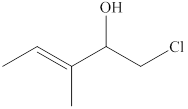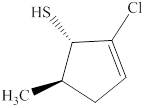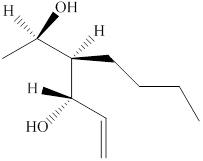
Concept explainers
(a)
Interpretation:
The substitutive name for the given compound is to be stated.
Concept introduction:
The systematic naming of organic compound is given by IUPAC. The naming of organic compound is done in such a way that the structure of organic compound is correctly interpreted from the name.
The hydrocarbons that are attached to the longest chain are called substituents and they are written as prefix in alphabetical order.
Answer to Problem 8.5P
The substitutive name for the given compound is
Explanation of Solution
The given compound is
The substitutive name for the given compound is
(b)
Interpretation:
The substitutive name for the given compound is to be stated.
Concept introduction:
The systematic naming of organic compound is given by IUPAC. The naming of organic compound is done in such a way that the structure of organic compound is correctly interpreted from the name.
The hydrocarbons that are attached to the longest chain are called substituents and they are written as prefix in alphabetical order.
Answer to Problem 8.5P
The substitutive name for the given compound is
Explanation of Solution
The given compound is
The substitutive name for the given compound is
(c)
Interpretation:
The substitutive name for the given compound is to be stated.
Concept introduction:
The systematic naming of organic compound is given by IUPAC. The naming of organic compound is done in such a way that the structure of organic compound is correctly interpreted from the name.
The hydrocarbons that are attached to the longest chain are called substituents and they are written as prefix in alphabetical order.
Answer to Problem 8.5P
The substitutive name for the given compound is
Explanation of Solution
The given compound is shown below.

Figure 1
The given compound has a longest chain of five carbon atoms with a double bond on third carbon atom. It is an
The use of prefix
The substitutive name for the given compound is
(d)
Interpretation:
The substitutive name for the given compound is to be stated.
Concept introduction:
The systematic naming of organic compound is given by IUPAC. The naming of organic compound is done in such a way that the structure of organic compound is correctly interpreted from the name.
The hydrocarbons that are attached to the longest chain are called substituents and they are written as prefix in alphabetical order.
Answer to Problem 8.5P
The substitutive name for the given compound is
Explanation of Solution
The given compound is shown below.

Figure 2
The given compound has a cyclic ring of five carbon atoms with a double bond on second carbon atom. It is an alkene, the suffix used for an alkene is –ene. Therefore, the parent name is
The naming of chiral center and geometric isomers are based on Cahn-Ingold-Prelog priority rules. If the priority assigned to each group attached to the chirality center in a molecule is in a clockwise direction, then it is the R-stereoisomer, and if this is counter-clockwise, then it is the S-stereoisomer. R and S-stereoisomer are mirror images of each other. Therefore, the name of this compound is
The substitutive name for the given compound is
(e)
Interpretation:
The substitutive name for the given compound is to be stated.
Concept introduction:
The systematic naming of organic compound is given by IUPAC. The naming of organic compound is done in such a way that the structure of organic compound is correctly interpreted from the name.
The hydrocarbons that are attached to the longest chain are called substituents and they are written as prefix in alphabetical order.
Answer to Problem 8.5P
The substitutive name for the given compound is
Explanation of Solution
The given compound is shown below.

Figure 3
The given compound has a chain of six carbon atoms with a double bond on fifth carbon atom. It is an alkene, the suffix used for an alkene is –ene. Therefore, the parent name is
The naming of chiral center and geometric isomers are based on Cahn-Ingold-Prelog priority rules. If the priority assigned to each group attached to the chirality center in a molecule is in a clockwise direction, then it is the R-stereoisomer, and if this is counter-clockwise, then it is the S-stereoisomer. R and S-stereoisomer are mirror images of each other. Therefore, the name of this compound is
The substitutive name for the given compound is
(f)
Interpretation:
The substitutive name for the given compound is to be stated.
Concept introduction:
The systematic naming of organic compound is given by IUPAC. The naming of organic compound is done in such a way that the structure of organic compound is correctly interpreted from the name.
The hydrocarbons that are attached to the longest chain are called substituents and they are written as prefix in alphabetical order.
Answer to Problem 8.5P
The substitutive name for the given compound is
Explanation of Solution
The given compound is shown below.

Figure 4
It consists of a cyclic ring of six carbon atoms. Therefore, the parent name is cyclohexa. There are two double bonds present at the second and fifth carbon atom of the ring. Also, one hydroxyl group is attached at the first carbon atom. Therefore, the name of this compound is
The substitutive name for the given compound is
(g)
Interpretation:
The substitutive name for the given compound is to be stated.
Concept introduction:
The systematic naming of organic compound is given by IUPAC. The naming of organic compound is done in such a way that the structure of organic compound is correctly interpreted from the name.
The hydrocarbons that are attached to the longest chain are called substituents and they are written as prefix in alphabetical order.
Answer to Problem 8.5P
The substitutive name for the given compound is
Explanation of Solution
The given compound is shown below.

Figure 5
It consists of a chain of five carbon atoms with hydroxyl group attached at the second carbon atom. The alcohols contain hydroxyl
The substitutive name for the given compound is
(h)
Interpretation:
The substitutive name for the given compound is to be stated.
Concept introduction:
The systematic naming of organic compound is given by IUPAC. The naming of organic compound is done in such a way that the structure of organic compound is correctly interpreted from the name.
The hydrocarbons that are attached to the longest chain are called substituents and they are written as prefix in alphabetical order.
Answer to Problem 8.5P
The substitutive name for the given compound is
Explanation of Solution
The given compound is shown below.

Figure 6
It consists of a chain of three carbon atoms with thiol group attached at the second carbon atom. One methyl group is attached at the second carbon atom. Therefore, the name of this compound is
The substitutive name for the given compound is
Want to see more full solutions like this?
Chapter 8 Solutions
ORGANIC CHEMISTRY SAPLING ACCESS + ETEX
- Consider this step in a radical reaction: Y What type of step is this? Check all that apply. Draw the products of the step on the right-hand side of the drawing area below. If more than one set of products is possible, draw any set. Also, draw the mechanism arrows on the left-hand side of the drawing area to show how this happens. ionization propagation initialization passivation none of the abovearrow_forward22.16 The following groups are ortho-para directors. (a) -C=CH₂ H (d) -Br (b) -NH2 (c) -OCHS Draw a contributing structure for the resonance-stabilized cation formed during elec- trophilic aromatic substitution that shows the role of each group in stabilizing the intermediate by further delocalizing its positive charge. 22.17 Predict the major product or products from treatment of each compound with Cl₁/FeCl₂- OH (b) NO2 CHO 22.18 How do you account for the fact that phenyl acetate is less reactive toward electro- philic aromatic substitution than anisole? Phenyl acetate Anisole CH (d)arrow_forwardShow how to convert ethyl benzene to (a) 2,5-dichlorobenzoic acid and (b) 2,4-dichlorobenzoic acid.arrow_forward
- Help me solve this problem. Thank you in advance.arrow_forward22.7 Predict the monoalkylated products of the following reactions with benzene. (a) AlCl3 Ya (b) AlCl3 (c) H3PO4 (d) 22.8 Think-Pair-Share AICI3 The reaction below is a common electrophilic aromatic substitution. SO3 H₂SO4 SO₂H (a) Draw the reaction mechanism for this reaction using HSO,+ as the electrophile. (b) Sketch the reaction coordinate diagram, where the product is lower in energy than the starting reactant. (c) Which step in the reaction mechanism is highest in energy? Explain. (d) Which of the following reaction conditions could be used in an electrophilic aro- matic substitution with benzene to provide substituted phenyl derivatives? (i) AICI3 HNO3 H₂SO4 K2Cr2O7 (iii) H₂SO4 (iv) H₂PO₁arrow_forwardIs an acid-base reaction the only type of reaction that would cause leavening products to rise?arrow_forward
- Help me understand this! Thank you in advance.arrow_forward22.22 For each compound, indicate which group on the ring is more strongly activating and then draw a structural formula of the major product formed by nitration of the compound. Br CHO (a) CH3 (b) (c) CHO CH3 SO₂H (d) ☑ OCHS NO₂ (e) (f) CO₂H NHCOCH3 NHCOCH, (h) CHS 22.23 The following molecules each contain two aromatic rings. (b) 000-100- H3C (a) (c) Which ring in each undergoes electrophilic aromatic substitution more readily? Draw the major product formed on nitration.arrow_forwardV Consider this step in a radical reaction: Br: ? What type of step is this? Check all that apply. Draw the products of the step on the right-hand side of the drawing area below. If more than one set of products is possible, draw any set. Also, draw the mechanism arrows on the left-hand side of the drawing area to show how this happens. ⚫ionization termination initialization neutralization none of the abc Explanation Check 80 Ο F3 F1 F2 2 F4 01 % do5 $ 94 #3 X 5 C MacBook Air 25 F5 F6 66 ©2025 ˇ F7 29 & 7 8arrow_forward
- Show how to convert ethyl benzene to (a) 2,5-dichlorobenzoic acid and (b) 2,4-dichlorobenzoic acid.arrow_forwardno aiarrow_forwardPolymers may be composed of thousands of monomers. Draw three repeat units (trimer) of the polymer formed in this reaction. Assume there are hydrogen atoms there are hydrogen atoms on the two ends of the trimer. Ignore inorganic byproducts.arrow_forward

 Chemistry: Principles and PracticeChemistryISBN:9780534420123Author:Daniel L. Reger, Scott R. Goode, David W. Ball, Edward MercerPublisher:Cengage Learning
Chemistry: Principles and PracticeChemistryISBN:9780534420123Author:Daniel L. Reger, Scott R. Goode, David W. Ball, Edward MercerPublisher:Cengage Learning Introductory Chemistry: An Active Learning Approa...ChemistryISBN:9781305079250Author:Mark S. Cracolice, Ed PetersPublisher:Cengage Learning
Introductory Chemistry: An Active Learning Approa...ChemistryISBN:9781305079250Author:Mark S. Cracolice, Ed PetersPublisher:Cengage Learning Chemistry: Principles and ReactionsChemistryISBN:9781305079373Author:William L. Masterton, Cecile N. HurleyPublisher:Cengage Learning
Chemistry: Principles and ReactionsChemistryISBN:9781305079373Author:William L. Masterton, Cecile N. HurleyPublisher:Cengage Learning



